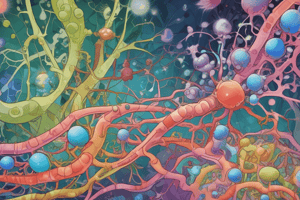Podcast
Questions and Answers
What is the primary carbon chain length of palmitate?
What is the primary carbon chain length of palmitate?
- 18 carbons
- 20 carbons
- 14 carbons
- 16 carbons (correct)
Which system is primarily responsible for elongating fatty acids in the human body?
Which system is primarily responsible for elongating fatty acids in the human body?
- Golgi Apparatus System
- Cytoplasmic Fatty Acid System
- Mitochondrial Transport System
- Endoplasmic Reticulum System (correct)
Which compound is added to palmitate during the elongation process in the endoplasmic reticulum?
Which compound is added to palmitate during the elongation process in the endoplasmic reticulum?
- Acetyl CoA
- Propionyl CoA
- Butyryl CoA
- Malonyl CoA (correct)
What is one of the key characteristics of triglycerides (TAG) in relation to water solubility?
What is one of the key characteristics of triglycerides (TAG) in relation to water solubility?
In which organelle are the enzymes for fatty acid elongation predominantly found?
In which organelle are the enzymes for fatty acid elongation predominantly found?
What type of energy storage do adipocytes primarily use?
What type of energy storage do adipocytes primarily use?
What is the common product formed when elongating palmitate in the endoplasmic reticulum?
What is the common product formed when elongating palmitate in the endoplasmic reticulum?
What is the main purpose of converting fatty acids into TAG?
What is the main purpose of converting fatty acids into TAG?
Which two-carbon unit is typically used in the mitochondrial elongation system?
Which two-carbon unit is typically used in the mitochondrial elongation system?
What characteristic makes TAG an efficient form for energy storage?
What characteristic makes TAG an efficient form for energy storage?
What is the recommended intake percentage of essential fatty acids to prevent deficiency symptoms?
What is the recommended intake percentage of essential fatty acids to prevent deficiency symptoms?
Which essential fatty acid is a precursor to the neuronal fatty acid C22:6ω3?
Which essential fatty acid is a precursor to the neuronal fatty acid C22:6ω3?
What is indicated as a connection between essential fatty acid metabolism and specific diseases?
What is indicated as a connection between essential fatty acid metabolism and specific diseases?
Which characteristic is associated with long chain fatty acids?
Which characteristic is associated with long chain fatty acids?
Which of the following conditions is NOT associated with essential fatty acid deficiency?
Which of the following conditions is NOT associated with essential fatty acid deficiency?
What process involves synthesizing glycerol from gluconeogenic precursors in adipose tissue?
What process involves synthesizing glycerol from gluconeogenic precursors in adipose tissue?
What is the primary form of fatty acids found in plasma?
What is the primary form of fatty acids found in plasma?
In palmitoleic acid, where is the double bond located?
In palmitoleic acid, where is the double bond located?
What condition has been linked to elevated levels of very long chain polyenoic acids in the brain?
What condition has been linked to elevated levels of very long chain polyenoic acids in the brain?
Which of the following is the main transport protein for long chain fatty acids in plasma?
Which of the following is the main transport protein for long chain fatty acids in plasma?
What percentage of fatty acids in plasma are considered long chain fatty acids?
What percentage of fatty acids in plasma are considered long chain fatty acids?
Which of the following is NOT a form in which fatty acids are found in the plasma?
Which of the following is NOT a form in which fatty acids are found in the plasma?
Which of the following best describes the nature of the fatty acid chains found in plasma lipoproteins?
Which of the following best describes the nature of the fatty acid chains found in plasma lipoproteins?
What type of bond is used to number the carbon atoms in the fatty acid chain?
What type of bond is used to number the carbon atoms in the fatty acid chain?
Which lipoprotein particle primarily contains triglycerides?
Which lipoprotein particle primarily contains triglycerides?
What is the main function of acetyl CoA-ACP acetyltransacylase in prokaryotes?
What is the main function of acetyl CoA-ACP acetyltransacylase in prokaryotes?
Which factor leads to decreased enzyme synthesis of acetyl CoA carboxylase?
Which factor leads to decreased enzyme synthesis of acetyl CoA carboxylase?
What happens to the two-carbon fragment from Acetyl-S-ACP during the reaction with the enzyme?
What happens to the two-carbon fragment from Acetyl-S-ACP during the reaction with the enzyme?
What is the product of the reaction catalyzed by malonyl CoA-ACP transacylase?
What is the product of the reaction catalyzed by malonyl CoA-ACP transacylase?
Which of the following describes the structure of the fatty acid synthase complex in eukaryotes?
Which of the following describes the structure of the fatty acid synthase complex in eukaryotes?
What is the role of the acyl carrier protein (ACP) in the context of fatty acid synthesis?
What is the role of the acyl carrier protein (ACP) in the context of fatty acid synthesis?
What is the effect of a high calorie-high carbohydrate diet on the fatty acid synthesis process?
What is the effect of a high calorie-high carbohydrate diet on the fatty acid synthesis process?
Which of the following is NOT a product of the reactions involving ACP?
Which of the following is NOT a product of the reactions involving ACP?
What is transferred to the ACP from malonyl CoA in fatty acid synthase reactions?
What is transferred to the ACP from malonyl CoA in fatty acid synthase reactions?
What is the primary role of fatty acyl CoA synthetase in fatty acid metabolism?
What is the primary role of fatty acyl CoA synthetase in fatty acid metabolism?
Which of the following correctly describes the first step in TAG synthesis from glycerol phosphate?
Which of the following correctly describes the first step in TAG synthesis from glycerol phosphate?
How does the preference for fatty acyl CoA differ when synthesizing TAG in the human mammary gland?
How does the preference for fatty acyl CoA differ when synthesizing TAG in the human mammary gland?
What key product is yielded from the acylation of lysophosphatidate in TAG synthesis?
What key product is yielded from the acylation of lysophosphatidate in TAG synthesis?
What is the outcome of the second acylation step during TAG synthesis?
What is the outcome of the second acylation step during TAG synthesis?
Which of the following statements is true regarding the activation of fatty acids?
Which of the following statements is true regarding the activation of fatty acids?
What process follows the activation of free fatty acids for TAG synthesis?
What process follows the activation of free fatty acids for TAG synthesis?
Which fatty acid characteristic influences the acylation process during TAG synthesis?
Which fatty acid characteristic influences the acylation process during TAG synthesis?
What is a key characteristic of dihydroxyacetone phosphate (DHAP) in relation to TAG synthesis?
What is a key characteristic of dihydroxyacetone phosphate (DHAP) in relation to TAG synthesis?
Which reaction does NOT occur during TAG synthesis involving glycerol phosphate?
Which reaction does NOT occur during TAG synthesis involving glycerol phosphate?
Flashcards are hidden until you start studying
Study Notes
Long Chain Fatty Acids
- Predominantly hydrophobic and highly insoluble in water.
- Transported in plasma bound to proteins, primarily albumin.
- Over 90% of circulating fatty acids are contained in lipoprotein particles such as TAG, cholesteryl esters, and phospholipids.
Fatty Acid Synthesis Reactions
- Transfer of Acetate: Acetyl CoA transfers acetate to the -SH group of acyl carrier protein (ACP), catalyzed by acetyl CoA-ACP acetyltransacylase.
- Transfer of Two-Carbon Fragment: Acetyl-S-ACP is transferred to a cysteine residue on the enzyme; this is a temporary holding site.
- Transfer of Malonate: Vacant ACP accepts a three-carbon malonate unit from malonyl CoA, catalyzed by malonyl CoA-ACP transacylase.
- Production of Palmitate: A fully saturated fatty acid with 16 carbons, resulting from fatty acid synthase activity, which can be elongated or desaturated by other enzymatic processes.
Functional Aspects of Fatty Acids
- Fatty Acid Synthase: A multienzyme complex in eukaryotes consisting of a dimer with seven enzymatic activities and a covalent attachment domain.
- Elongation Systems: Extend fatty acid chains beyond 16 carbons by adding 2-carbon units.
- Includes endoplasmic reticulum (most active) and mitochondrial elongation systems.
Storage and Synthesis of Triglycerides (TAG)
- Fatty acids are converted into TAG for transport and energy storage.
- TAGs are slightly soluble in water, forming oily droplets within adipocytes due to low solubility.
- Primarily stored in adipose tissue as the major energy reserve.
Essential Fatty Acids
- Essential fatty acids must comprise 1% to 2% of total caloric intake to prevent deficiency symptoms.
- Linoleic acid and its derivatives play critical roles in skin health and neuronal function.
- Deficiency in essential fatty acids leads to various health issues including skin problems and potential connections to metabolic disorders.
Abnormal Metabolism and Related Diseases
- Disorders including cystic fibrosis, Sjögren-Larsson syndrome, and more can exhibit abnormal essential fatty acid metabolism.
- Elevated levels of very long chain polyenoic acids are observed in certain neurological conditions, such as Zellweger syndrome.
- Glyceroneogenesis in adipose tissue synthesizes glycerol from gluconeogenic precursors, especially during fasting, modulating fatty acid release into circulation.
Studying That Suits You
Use AI to generate personalized quizzes and flashcards to suit your learning preferences.




